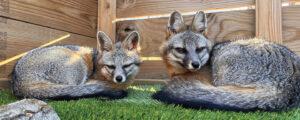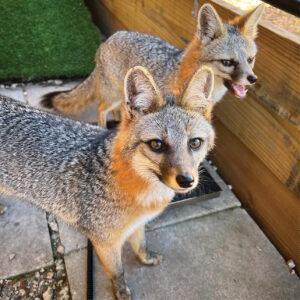
The gray fox (Urocyon cinereoargenteus) is a fascinating species native to North America, known for its distinctive salt-and-pepper coat and bushy tail with a black tip. Unlike its red fox cousins, the gray fox is an exceptional climber, often found scaling trees to escape predators or forage for food. This nocturnal omnivore thrives in a variety of habitats, including deciduous forests, wooded areas, and scrublands, where it can find a mix of cover and open space to hunt small mammals, birds, fruits, and insects.
Habitat and Behavior
Gray foxes are highly adaptable, often residing in mixed woodlands and dense brush where they can utilize their climbing abilities to seek refuge or hunt. They are solitary animals, except during the breeding season or when a female is raising her young. Typically, they create dens in hollow trees, under rocky outcrops, or in burrows they dig themselves. Gray foxes are mostly active during the night and twilight hours, making them elusive and difficult to spot.
Where to See Gray Foxes in the Wild

For those interested in seeing gray foxes in their natural habitat, it is best to explore dense, mixed forests or areas with abundant brush and cover, especially during early morning or dusk when these animals are most active. In Florida, gray foxes can be found in state parks, wildlife reserves, and other protected areas that provide the undisturbed, wooded environments they prefer.
What to Do If You Encounter a Gray Fox
If you come across a gray fox in the wild, it is important to remain calm and observe from a distance. Gray foxes are generally shy and will likely move away if they detect humans nearby. Do not attempt to approach or feed them, as this can make them more accustomed to human presence, which is dangerous for both the animal and humans. If a gray fox appears ill or behaves unusually, contact local wildlife authorities.
Conservation Efforts
While gray foxes are not currently listed as endangered, they face threats from habitat loss, vehicle collisions, and disease. Conservation efforts focus on preserving natural habitats and promoting safe coexistence between humans and wildlife. At the North Florida Wildlife Center, we are home to two non-releasable gray foxes, Cypress and Willow, who were raised in a home as babies and now cannot survive on their own in the wild. Our efforts aim to educate the public about the importance of protecting these unique animals and their habitats to ensure their continued presence in the wild. By understanding and respecting the gray fox and its habitat, we can all play a part in ensuring these remarkable creatures continue to thrive in our forests and natural landscapes. ![]()
Ryan Reines
North Florida Wildlife Center


